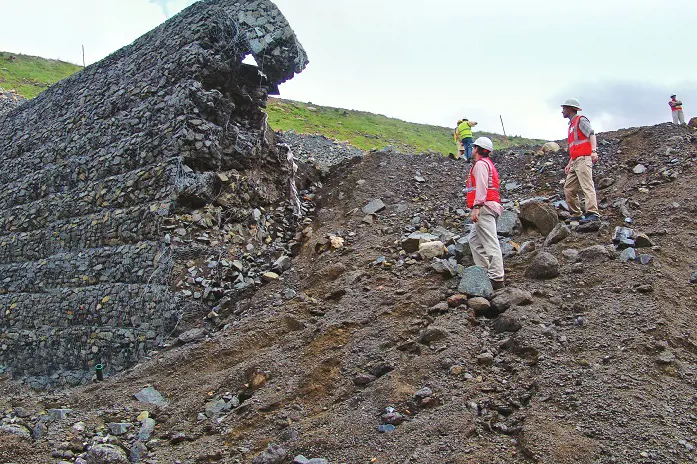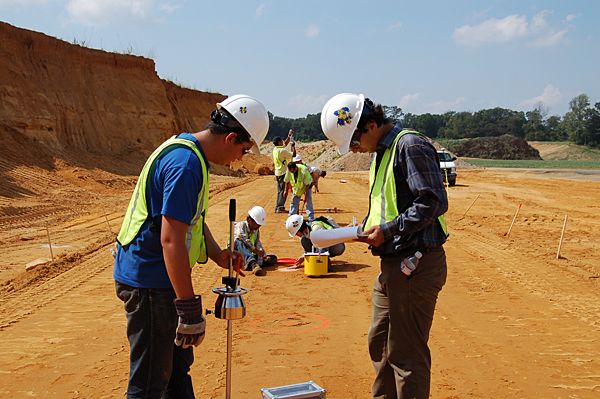How a Geotechnical Specialist Can Make Certain the Success of Your Structure Foundations
How a Geotechnical Specialist Can Make Certain the Success of Your Structure Foundations
Blog Article
Examining the Interdisciplinary Nature of Geotechnical Design and Its Impact on Ground Improvement and Structure Layout
By incorporating understandings from architectural, ecological, and geological self-controls, geotechnical designers are equipped to resolve complex dirt behaviors and site-specific challenges. This joint approach not only boosts the efficiency of techniques such as soil stabilization and vibrant compaction yet likewise guarantees that jobs stick to sustainability concepts.
Overview of Geotechnical Design
Geotechnical engineering is an essential branch of civil engineering that concentrates on the actions of earth materials and their communication with structures. This discipline includes the research study of rock, groundwater, and soil, aiming to comprehend their properties and exactly how they influence the efficiency of civil design tasks. Geotechnical designers examine the mechanical and hydraulic actions of these materials to make certain the security and security of frameworks such as buildings, bridges, and maintaining wall surfaces.
The range of geotechnical engineering consists of website investigations, dirt tasting, and screening, in addition to analysis of dirt mechanics and rock auto mechanics. Designers use advanced strategies to examine ground problems, determine prospective threats, and design efficient ground renovation options. This might entail techniques such as soil stabilization, grouting, and the use of geosynthetics, which enhance the stamina and resilience of the ground.
Additionally, geotechnical engineering plays a crucial duty in structure style, figuring out suitable foundation types based on soil attributes and loading problems. By integrating strenuous screening and evaluation, geotechnical engineers contribute substantially to the sustainability and durability of framework, guaranteeing that structures can hold up against functional and environmental stress and anxieties with time.
Secret Interdisciplinary Relationships

Furthermore, environmental design plays a vital role in evaluating the influence of geotechnical activities on the bordering ecosystem. This partnership is crucial for establishing lasting methods that decrease environmental destruction throughout excavation or ground renovation procedures.
Furthermore, the assimilation of geotechnical engineering with geology boosts the understanding of subsurface conditions, helping with more precise website characterizations (geotechnical specialist). This connection aids in risk assessment, especially in locations vulnerable to landslides or seismic task, thereby notifying threat reduction strategies
Last but not least, advancements in modern technology have actually brought about interdisciplinary cooperation with data scientific research and geoinformatics. These fields add to enhanced modeling and evaluation strategies, permitting extra precise forecasts of soil actions under numerous problems. Hence, the interconnectedness of these self-controls enhances geotechnical engineering, advertising development and efficiency in foundation design and ground renovation.
Ground Enhancement Methods
Ground improvement techniques are essential approaches used to improve the design residential or commercial properties of soil, therefore raising its load-bearing ability and stability. These strategies are specifically essential in areas where all-natural dirt conditions are inadequate for sustaining structural tons or where environmental elements may compromise soil stability.
Commonalities improvement approaches include dirt compaction, which boosts thickness and decreases void spaces, and grouting, which includes infusing products right into dirt to fill up gaps and bind particles with each other - all about geotechnical engineering. Other methods consist of the setup of soil nails and anchors, which give added assistance, and using geosynthetics to strengthen soil structures. Deep blending approaches, such as soil-cement columns, can likewise dramatically boost the stamina and stiffness of weak dirts
Furthermore, dynamic compaction and vibro-replacement methods are frequently used to enhance soil residential or commercial properties sitting. These approaches can minimize concerns connected to negotiation and liquefaction, particularly in seismic areas. By using a mix of these innovative strategies, geotechnical designers can effectively resolve site-specific obstacles, ensuring that the structure systems will certainly execute effectively under anticipated loading problems, hence adding to total task success.
Structure Design Considerations
Efficient structure layout considerations are crucial for the long life and security of structures. A properly designed foundation has to sufficiently support the Continue load of the building while suiting soil conditions, ecological elements, and potential adjustments gradually. Secret variables consist of dirt bearing ability, settlement qualities, and groundwater conditions.
Understanding the soil account via geotechnical investigations is necessary, as it notifies the selection of structure type-- be it superficial, deep, or specialized methods such as heap foundations or mat structures. The anticipated lots, including online, dead, and environmental tons, have to be properly calculated to ensure the structure can withstand possible failing mechanisms, such as moving, rescinding, or excessive negotiation.
Furthermore, considerations for frost depth, seismic activity, and potential dirt liquefaction in seismic zones are important. Furthermore, drainage and moisture control should be integrated right into the structure layout to minimize issues connected to hydrostatic pressure and soil disintegration.
Cooperation among architects, engineers, and geotechnical professionals is important to create a comprehensive foundation design that not only meets regulative demands yet also makes certain the lasting efficiency and safety and security of the framework. Inevitably, detailed planning and ingenious services are required to attend to the complexities fundamental in foundation layout.
Case Researches and Best Practices

One remarkable situation research includes the use of deep dirt blending in a skyscraper project in a seismic zone. This method substantially enhanced the dirt's stamina and security, permitting a more secure and more efficient structure system (all about geotechnical engineering). The job highlighted the importance of look here choosing proper ground renovation techniques based upon site-specific conditions, consisting of dirt kind and loading needs
Another example is the application of vibrant compaction for boosting the bearing capacity Visit This Link of weak soils beneath a commercial facility. This approach effectively reduced settlement worries and boosted total website efficiency, showing the effectiveness of incorporating typical design techniques with modern technology.
Ideal practices derived from these study emphasize the need of detailed site investigations, collaboration among multidisciplinary groups, and the unification of innovative modeling tools. By embracing these lessons, geotechnical designers can optimize structure layouts and ground renovation techniques, inevitably bring about safer and much more lasting building results.
Final Thought
In conclusion, the interdisciplinary nature of geotechnical engineering considerably improves ground renovation and foundation style. By incorporating concepts from different design disciplines, tailored methods are established to deal with particular challenges connected to soil properties and environmental impacts.
The range of geotechnical design consists of website investigations, soil sampling, and testing, as well as analysis of soil technicians and rock technicians. The connection between geotechnical engineering and architectural design is particularly essential, as the performance of frameworks is heavily influenced by dirt actions and properties.Typical ground improvement approaches include dirt compaction, which enhances density and decreases void areas, and grouting, which includes infusing materials into soil to fill up gaps and bind fragments together. Other methods consist of the setup of soil nails and supports, which give extra support, and the usage of geosynthetics to enhance soil structures. A well-designed foundation must adequately sustain the tons of the building while suiting soil problems, environmental variables, and prospective adjustments over time.
Report this page